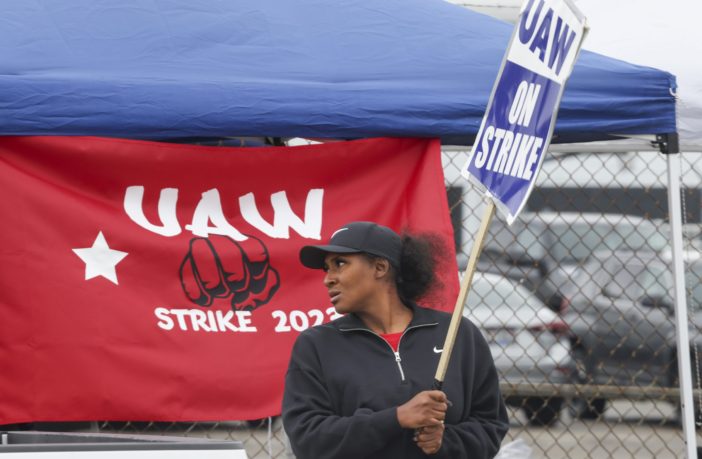By Megan Sayles,
AFRO Business Writer,
msayles@afro.com
Two major labor unions in the automobile and health care industry have gone on strike. Kaiser Permanente, the largest nonprofit health care provider in the U.S., had more than 75,000 employees leave their posts on Oct. 4 after contract negotiations between the Coalition of Kaiser Permanente Unions and the private nonprofit employer came to no resolution on Sep. 30.
Meanwhile, the International Union, United Automobile, Aerospace and Agricultural Implement Workers of America (UAW) announced that it would expand its strike against leading automakers, Stellantis, General Motor (GM) and Ford Motor Company (Ford), on Sep. 29.
Though distinct in industry, workers from both labor unions are calling for better pay from their employers.
Coalition unions begins battle with Kaiser Permanente
The Coalition of Kaiser Permanente Union’s three-day strike ran from Oct. 4 at 6 a.m. through Oct. 7 at 6 a.m. and made history as the largest health care strike in U.S. history.
Kaiser Permanente workers, including nurses, optometrists and pharmacists, across California, Oregon, Washington, Colorado, Virginia and D.C. led the picketing. Maryland workers were not included in the strike because their contract does not expire until December.
Days before the strike, the coalition released a statement on Sep. 30 saying it remained “far apart” with Kaiser Permanente on issues including across-the-board raises, expanded protections against subcontracting and outsourcing, better performance sharing bonuses and improvements to retiree medical plans.
“In a few hours, our contract will expire, and it doesn’t look like we will have a new agreement,” wrote the coalition in the statement. “There have been good discussions with Kaiser on a number of issues, and while there is no concrete agreement, we can see a path to resolution on raising shift differentials, a fair remote work agreement, and investments in training for both current employees to promote to harder to fill jobs and community members to become the healthcare workforce needed for the future.”
Kaiser Permanente alerted patients that they should expect longer wait times and that some departments would temporarily close due to the strike.
On Sep. 29, the healthcare organization released a statement noting that its package proposal created new minimum wages, provided guaranteed across-the-board wages, enhanced performance sharing bonuses, increased funding for workforce development and increased health reimbursement for retirees.
But, the terms of these concessions did not meet the coalition’s standards.
“Both Kaiser Permanente management and Coalition union representatives are still at the bargaining table, having worked through the night in an effort to reach an agreement,” Wayne Davis, a spokesperson for Kaiser Permanente, told the AFRO in an email on Oct. 4. “There has been a lot of progress, with agreements reached on several specific proposals late Tuesday.”
“We remain committed to reaching a new agreement that continues to provide our employees with market-leading wages, excellent benefits, generous retirement income plans, and valuable professional development opportunities.”
If an agreement is not reached between the parties, the coalition said it would strike again in November.
“If Kaiser continues to commit unfair labor practices, we are prepared to engage in another longer, stronger strike in November to protest Kaiser’s unfair labor practices when additional coalition members in Kaiser’s newest market in Washington state can join us (their contract expires Oct. 31),” the coalition wrote in a statement.
UAW expands strike against the Big Three
UAW’s “Stand Up and Strike” has also become the largest auto strike in U.S. history. It’s the first time the union has called a strike against Ford, GM and Stellantis at the same time. Auto workers are calling for better wages and benefits, as well as job security from the automobile companies.
The first 13,000 walkouts took place on Sep. 15 at several of the automakers’ plants in Michigan, Missouri and Ohio. Since then, UAW has expanded the strike on more than one occasion, bringing the total number of walkouts to 25,000 across 43 facilities in 21 states.
“The big three have made a quarter trillion dollars over the last 10 years. They made $21 billion in profits in the first half of this year alone. We will not stand by as corporate executives and the rich continue to make extraordinary profits while the rest of us continue to get left further and further behind,” said Shawn Fain, president of UAW, in a video on the Stand Up Strike’s Youtube channel. “Our goal is not to strike, our goal is to bargain a fair contract, but if we have to strike to win economic and social justice, then we will shut down the Big Three.”
UAW members’ demands include restoring cost of living adjustments (COLA), big wage increases, eliminating tiers, implementing a defined benefit pension for all workers, more paid time off and re-establishing retiree medical benefits and significantly increasing retiree pay, according to UAW.
As a result of UAW’s strike action, the three automakers have had to make more than 3,000 lay-offs. While Fain said the union has made significant progress with Stellantis on COLA in a statement on Sep. 29, it continues to battle Ford and GM.
“Stellantis has been intensely working with the UAW to find solutions to the issues that are of most concern to our employees while ensuring the company can remain competitive given the market’s fierce competition. We have made progress in our discussions, but gaps remain,” Jodi Tinson, a spokesperson for Stellantis, told the AFRO in an email on Oct. 4. “We are committed to continue working through these issues in an expeditious manner to reach a fair and responsible agreement that gets everyone back to work as soon as possible.”
One unique issue in UWA’s fight against Ford is the union’s concerns over losing jobs to the automaker’s electrical vehicle (EV) transition. Ford is currently in the process of constructing several EV plants in Michigan, Kentucky and Tennessee, and the company has not declared that it will employ union labor at the new facilities.
But, Ford president and CEO Jim Farley claims EVs will not pose a threat to union members’ job security.
“I need to be clear about one thing because the UAW is scaring our workers by repeating something that is just factually not true. None of our workers today are going to lose their jobs due to our battery plants during this contract period or even beyond this contract,” said Farley. “In fact, for the foreseeable future, we will have to hire more workers as some workers retire in order to keep up with the demand for our incredible new vehicles. We are open to working with the union on a fair deal for battery plants,but these are multi-billion dollar investments and the future of our industry is in the balance.”
On Oct. 3, Ford announced that it put forward a new deal to UAW that included record pay, benefits and product commitments, which puts hourly and salaried employees among the top 25 percent of all U.S. jobs. But Farley said an impasse could occur if Ford and UAW cannot reach an agreement on battery plants.
“Here’s the bottom line from Ford’s perspective, first, Ford has offered an incredible contract that would change the lives of over 57,000 workers for the better. Second, we believe the UAW is holding up the deal over battery plants that won’t come online for another two to three years,” said Jim Farley, CEO and president of Ford, at a Sep. 29 press conference. “Finally, we still have time to reach an agreement and avert a real disaster, but not much more time given the fragility of the supply base.”
Megan Sayles is a Report for America corps member.



